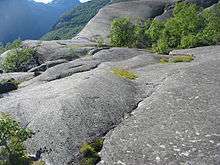Abrasion (geology)


Abrasion is the mechanical scraping of a rock surface by friction between rocks and moving particles during their transport by wind, glacier, waves, gravity, running water or erosion. After friction, the moving particles dislodge loose and weak debris from the side of the rock.
The intensity of abrasion depends on the hardness, concentration, velocity and mass of the moving particles.
Abrasion in coastal erosion
Coastal abrasion occurs as breaking waves which contain sand and larger fragments erode the shoreline or headland. This removes material resulting in undercutting and possible collapse of unsupported overhanging cliffs.
Abrasion platform
Abrasion platforms are shore platforms where wave action abrasion is a prominent process. If it is currently being fashioned, it will be exposed only at low tide, but there is a possibility that the wave-cut platform will be hidden sporadically by a mantle of beach shingle (the abrading agent). If the platform is permanently exposed above the high-water mark, it is probably a raised beach platform, which is not considered a product of abrasion.